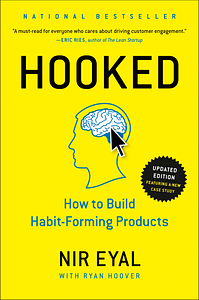Take a photo of a barcode or cover
informative
fast-paced
There great insights and ideas for anyone building a product!
It’s pretty short, so if you don’t find anything valuable there you won’t have wasted too much time on it ;)
It’s pretty short, so if you don’t find anything valuable there you won’t have wasted too much time on it ;)
Listened to this on Audible and finished it pretty quickly. Reading it may be more helpful to see some of the diagrams and illustrations to drive the points home. If you are aware of some of the tactics which current companies in the social media world are employing then this may not be a life-changing book. However, it does structure these tactics in a more scientific way by introducing the psychological terminology to explain it clearer. The biggest takeaway for me is how do you generate that hook cycle which he breaks down as trigger, action, variable reward, and investment.
This was an interesting book about product/service design. The premise of the book is that designers are trying to develop an addictive product, something that their customers "need" and so keep coming back for. While I think there's some truth that there are habit-forming products and technologies out there, I'm not sure that's the right goal. Granted, the book recognizes this; it even includes a chapter on the morality of designing such products. After reading it, I'm left wondering if I could actually develop something using these guidelines. I think it's not for me.
For his young age, Nir Eyal has managed to gain quite a bit of experience working in several successful startups. His book offers a more of a psychological explanation, into what turns certain products into habits, and offers different aspects to look into, when trying to build products and services that stick. At the end of the book, Eyal discusses the moral implications of turning the use of a product into a habit, and how to avoid turning it into abuse. This is a topic that is seldom discussed among startup founders and product builders, and I believe, needs to be voiced out more often.
Unlike "Traction", this book is not going to give you concrete steps and tools of how to achieve user growth and increase user acquisition, but will rather make you think, and put yourselves into the eyes of your potential customers.
Unlike "Traction", this book is not going to give you concrete steps and tools of how to achieve user growth and increase user acquisition, but will rather make you think, and put yourselves into the eyes of your potential customers.
Good. Not great. Poorly produced as a book, feel free to go for eBook version. In fact, his slide deck pretty much covers it.
inspiring
fast-paced
informative
medium-paced
Really Nice book and a great reading for whoever wants to build its own product.
The model is very intuitive and the examples presented by Eyal helps a lot to understand how trigger leads to action leads to reward and how investment binds the cycle to repeat itself.
It'd very good to keep in mind that, even though the model is simple and intuitive, it's not easy to apply. To create a working cycle (and responsibly), it demands lots of work, experience and a pinch of luck.
The model is very intuitive and the examples presented by Eyal helps a lot to understand how trigger leads to action leads to reward and how investment binds the cycle to repeat itself.
It'd very good to keep in mind that, even though the model is simple and intuitive, it's not easy to apply. To create a working cycle (and responsibly), it demands lots of work, experience and a pinch of luck.

